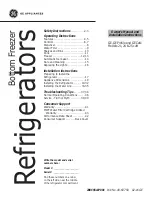
FOOD STORAGE GUIDE
Storing Fresh Food
Wrap or store food in the refrigerator in airtight and
moisture-proof material unless otherwise noted. This
prevents food odor and taste transfer throughout the
refrigerator. For dated products, check date code to
ensure freshness.
Butter or margarine
Keep opened butter in a covered dish or closed
compartment. When storing an extra supply, wrap
in freezer packaging and freeze.
Cheese
Store in the original wrapping until you are ready to
use it. Once opened, rewrap tightly in plastic wrap or
aluminum foil.
Milk
Wipe milk cartons. For best storage, place milk on interior
shelf, not on door shelf.
Eggs
Store in original carton on interior shelf, not on door shelf.
Fruit
Wash, let dry, and store in refrigerator in plastic bags or in
the crisper. Do not wash or hull berries until you are ready
to use them. Sort and keep berries in their original
container in a crisper, or store in a loosely closed paper
bag on a refrigerator shelf.
Leafy vegetables
Remove store wrapping and trim or tear off bruised and
discolored areas. Wash in cold water and drain. Place in a
plastic bag or plastic container and store in the crisper.
Vegetables with skins (carrots, peppers)
Place in plastic bags or plastic container and store
in crisper.
Fish
Snack pan
Store most chef fresh in original wrapping as long as it is
airtight and moisture-proof. Rewrap if necessary.
Leftovers
Cover leftovers with plastic wrap or aluminum foil. Plastic
containers with tight lids can also be used.
STORING FROZEN FOOD
NOTE:
For further information about preparing food for
freezing or food storage times, check a freezer guide or a
reliable cookbook.
USING YOUR REFRIGERATOR
19
Use fresh fish and shellfish the same day purchased.
WATER DISPENSER
Tray can be easily removed by pressing and pulling it.
Tilt up the front of tray slightly and snap the ribs into the
holes to reinstall the tray.
WARNING:
Do not throw your hands in the water & ice
opening. Doing so can result in amputation or cuts.
Holes
Ribs















































